Enhancement of Dynamic Damping in Eco-Friendly Railway Concrete Sleepers Using Waste-Tyre Crumb Rubber
Abstract
1. Introduction
2. Railway Applications
3. Methods
3.1. Rubber Wastes and Their Applications
3.2. Relevant Previous Studies
4. Materials
4.1. Cement
4.2. Silica Fume
4.3. Coarse Aggregates
4.4. Water
4.5. Admixture
4.6. Concrete
5. Experimental Results and Discussion
5.1. Compressive Strength
5.2. Splitting Tensile and Flexural Strengths
5.3. Electrical Resistivity
5.4. Vibration Damping
5.5. Dynamic Flexural Moduli
6. Conclusions
Author Contributions
Funding
Acknowledgments
Conflicts of Interest
References
- Gourley, J.T.; Johnson, G.B. Developments in geopolymer precast concrete. In Proceedings of the Geopolymer 2005 World Congress, Geopolymer Green Chemistry and Sustainable Development Solutions, Saint-Quentin, France, 29 June–1 July 2005; pp. 139–143. [Google Scholar]
- Kaewunruen, S.; You, R.; Ishida, M. Composites for Timber-Replacement Bearers in Railway Switches and Crossings. Infrastructures 2017, 2, 13. [Google Scholar] [CrossRef]
- Kaewunruen, S.; Wu, L.; Goto, K.; Najih, Y.M. Vulnerability of Structural Concrete to Extreme Climate Variances. Climate 2018, 6, 40. [Google Scholar] [CrossRef]
- FIP Commission on Prefabrication, FIP Commission on Prefabrication; Working Group on Concrete Railway Sleepers & Fédération Internationale de la Précontrainte. Working Group on Concrete Railway Sleepers. Concrete Railway Sleepers; Thomas Telford Services Ltd.: London, UK, 1987. [Google Scholar]
- Gupta, T.; Chaudhary, S.; Sharma, R.K. Mechanical and durability properties of waste rubber fiber concrete with and without silica fume. J. Clean. Prod. 2016, 112, 702–711. [Google Scholar] [CrossRef]
- Aiello, M.; Leuzzi, F. Waste tyre rubberized concrete: Properties at fresh and hardened state. Waste Manag. 2010, 30, 1696–1704. [Google Scholar] [CrossRef] [PubMed]
- Thomas, B.S.; Gupta, R.C. A comprehensive review on the applications of waste tire rubber in cement concrete. Renew. Sustain. Energy Rev. 2016, 54, 1323–1333. [Google Scholar] [CrossRef]
- Remennikov, A.M.; Kaewunruen, S. A review of loading conditions for railway track structures due to train and track vertical interaction. Struct. Control Health Monit. 2008, 15, 207–234. [Google Scholar] [CrossRef]
- Silva, É.A.; Pokropski, D.; You, R.; Kaewunruen, S. Comparison of structural design methods for railway composites andplastic sleepers and bearers. Aust. J. Struct. Eng. 2017, 18, 160–177. [Google Scholar] [CrossRef]
- Kaewunruen, S.; Remennikov, A.M. Progressive failure of prestressed concrete sleepers under multiple high-intensity impact loads. Eng. Struct. 2009, 31, 2460–2473. [Google Scholar] [CrossRef]
- Cai, H.Q. Structure analysis of railway. J. Hebei Inst. Arch. 2006, 29, 18–20. [Google Scholar]
- Kaewunruen, S.; Remennikov, A.M. Influence of voids and pockets on the vibration characteristics of prestressed concrete sleepers. In Proceedings of the Society of Experimental Mechanics (SEM) Annual Conference and Exhibition, Orlando, FL, USA, 19–22 February 2007; pp. 3–6. [Google Scholar]
- Esveld, C. Modern Railway Track, 2nd ed.; MRT-Productions: Delft, The Netherlands, 2001; ISBN 90-800324-3-3. [Google Scholar]
- Indraratna, B.; Rujikiatkamjorn, C.; Salim, W. Advanced Rail Geotechnology–Ballasted Track; CRC Press: London, UK, 2011. [Google Scholar]
- Remennikov, A.M.; Kaewunruen, S. Resistance of railway concrete sleepers to impact loading. In Proceedings of the 7th International Conference on Shock & Impact Loads on Structures, Beijing, China, 17–19 October 2007; pp. 489–496. [Google Scholar]
- You, R.; Li, D.; Ngamkhanong, C.; Janeliukstis, R.; Kaewunruen, S. Fatigue Life Assessment Method for Prestressed Concrete Sleepers. Front. Built Environ. 2017, 3, 68. [Google Scholar] [CrossRef]
- Zhang, X.; Thompson, D.J.; Squicciarini, G. Sound radiation from railway sleepers. J. Sound Vib. 2016, 369, 178–194. [Google Scholar] [CrossRef]
- Hameed, A.S.; Shashikala, A. Suitability of rubber concrete for railway sleepers. Perspect. Sci. 2016, 8, 32–35. [Google Scholar] [CrossRef]
- Salam, H.E.; Sherbini, A.S.; Seleem, M.H.; Balaha, M.M. Impact Resistance of Rubberized Concrete. Eng. Res. J. 2008, 31, 265–271. [Google Scholar]
- Topçu, İ.B.; Demir, A. Durability of Rubberized Mortar and Concrete. J. Mater. Civ. Eng. 2007, 19, 173–178. [Google Scholar] [CrossRef]
- Topçu, İ.B.; Şengel, S. Properties of concretes produced with waste concrete aggregate. Cem. Concr. Res. 2004, 34, 1307–1312. [Google Scholar] [CrossRef]
- Anagennisi Project. Rubberised Concrete. 2017. Available online: http://anagennisi.org/wordpress/portfolio/rubberised-concrete-optimised-mix (accessed on 14 February 2018).
- Sol-Sánchez, M.; Thom, N.; Moreno-Navarro, F.; Rubio-Gámez, M.; Airey, G. A study into the use of crumb rubber in railway ballast. Constr. Build. Mater. 2015, 75, 19–24. [Google Scholar] [CrossRef]
- Toutanji, H. The use of rubber tire particles in concrete to replace mineral aggregates. Cem. Concr. Compos. 1996, 18, 135–139. [Google Scholar] [CrossRef]
- Khaloo, A.R.; Dehestani, M.; Rahmatabadi, P. Mechanical properties of concrete containing a high volume of tire–rubber particles. Waste Manag. 2008, 28, 2472–2482. [Google Scholar] [CrossRef] [PubMed]
- Ganjian, E.; Khorami, M.; Maghsoudi, A.A. Scrap-tyre-rubber replacement for aggregate and filler in concrete. Constr. Build. Mater. 2009, 23, 1828–1836. [Google Scholar] [CrossRef]
- Paine, K.A.; Dhir, R.K.; Moroney, R.; Kopasakis, K. Use of Crumb Rubber to Achieve Freeze/Thaw Resisting Concrete. In Proceedings of the International Conference on Concrete for Extreme Conditions, Dundee, UK, 9–11 September 2002; pp. 485–498. [Google Scholar] [CrossRef]
- Hernández-Olivares, F.; Barluenga, G. Fire performance of recycled rubber-filled high-strength concrete. Cem. Concr. Res. 2004, 34, 109–117. [Google Scholar] [CrossRef]
- Fattuhi, N.; Clark, L. Cement-based materials containing shredded scrap truck tyre rubber. Constr. Build. Mater. 1996, 10, 229–236. [Google Scholar] [CrossRef]
- Van Dyk, B.J.; Edwards, J.R.; Dersch, M.S.; Ruppert, C.J., Jr.; Barkan, C.P.L. Evaluation of dynamic and impact wheel load factors and their application in design processes. Proc. Inst. Mech. Eng. Part F 2017, 231, 33–43. [Google Scholar] [CrossRef]
- Kaewunruen, S.; Remennikov, A.M. Sensitivity analysis of free vibration characteristics of an in situ railway concrete sleeper to variations of rail pad parameters. J. Sound Vib. 2006, 298, 453–461. [Google Scholar] [CrossRef]
- BS EN 13230 Concrete Sleepers and Bearers; British Standards Institute: London, UK, 2016.
- BS EN 934-2 Admixtures for Concrete, Mortar and Grout; British Standards Institute: London, UK, 2009.
- Mazloom, M.; Ramezanianpour, A.; Brooks, J. Effect of silica fume on mechanical properties of high-strength concrete. Cem. Concr. Compos. 2004, 26, 347–357. [Google Scholar] [CrossRef]
- Elkem-Microsilica Grade 940 for Construction. 2017. Available online: https://www.elkem.com/silicon-materials/high-performance-concrete/microsilica-concrete-grades/microsilica-grade-940-construction/ (accessed on 14 February 2018).
- BS EN 12620 Aggregates for Concrete; British Standards Institute: London, UK, 2013.
- BS EN 206-1 Concrete: Part 1—Specification, Performance, Production and Conformity; British Standards Institute: London, UK, 2000.
- Mirza, O.; Kaewunruen, S. Influence of shear bolt connections on modular precast steel-concrete composites for track support structures. Steel Comp. Struct. 2018, 27, 647–659. [Google Scholar]
- BS EN 13139 Aggregates for Mortar; British Standards Institute: London, UK, 2013.
- BS EN 12390-3 Testing Hardened Concrete: Part 3: Compressive Strength of Test Specimens; British Standards Institute: London, UK, 2009.
- Sukontasukkul, P.; Chaikaew, C. Properties of concrete pedestrian block mixed with crumb rubber. Constr. Build. Mater. 2006, 20, 450–457. [Google Scholar] [CrossRef]
- Atahan, A.O.; Yücel, A.Ö. Crumb rubber in concrete: Static and dynamic evaluation. Constr. Build. Mater. 2012, 36, 617–622. [Google Scholar] [CrossRef]
- He, L.; Ma, Y.; Liu, Q.; Mu, Y. Surface modification of crumb rubber and its influence on the mechanical properties of rubber-cement concrete. Constr. Build. Mater. 2016, 120, 403–407. [Google Scholar] [CrossRef]
- Su, H.; Yang, J.; Ling, T.; Ghataora, G.S.; Dirar, S. Properties of concrete prepared with waste tyre rubber particles of uniform and varying sizes. J. Clean. Prod. 2015, 91, 288–296. [Google Scholar] [CrossRef]
- BS EN 12390-6 Testing Hardened Concrete: Part 6: Tensile Splitting Strength of Test Specimens; British Standards Institute: London, UK, 2009.
- BS EN 12390-5 Testing Hardened Concrete: Part 5: Flexural Strength of Test Specimens; British Standards Institute: London, UK, 2009.
- Xiao, J.; Li, W.; Fan, Y.; Huang, X. An overview of study on recycled aggregate concrete in China (1996–2011). Constr. Build. Mater. 2012, 31, 364–383. [Google Scholar] [CrossRef]
- Çakır, Ö. Experimental analysis of properties of recycled coarse aggregate (RCA) concrete with mineral additives. Constr. Build. Mater. 2014, 68, 17–25. [Google Scholar] [CrossRef]
- Kaewunruen, S.; Meesit, R.; Mondal, P. Early age dynamic moduli of crumbed rubber concrete for compliant railway structures. J. Sustain. Cem.-Based Mater. 2017, 6, 281–292. [Google Scholar] [CrossRef]
- New York State Assembly. NYS Assembly Priority for Waste Tire Cleanups Finally a Reality. 2003. Available online: http://assembly.state.ny.us/comm/SolidWaste/20030714 (accessed on 14 February 2018).
- Remennikov, A.M.; Kaewunruen, S. Experimental load rating of aged railway concrete sleepers. Eng. Struct. 2014, 76, 147–162. [Google Scholar] [CrossRef]
- Zheng, L.; Sharon Huo, X.; Yuan, Y. Experimental investigation on dynamic properties of rubberized concrete. Constr. Build. Mater. 2008, 22, 939–947. [Google Scholar] [CrossRef]
- Kaewunruen, S.; Akono, A.-T.; Remennikov, A.M. Attenuation effect of material damping on impact vibration responses of railway concrete sleepers. GeoMEast 2018, accepted. [Google Scholar]
- Kaewunruen, S.; Meesit, R. Sensitivity of crumb rubber particle sizes on electrical resistance of rubberised concrete. Cogent Eng. 2016, 3, 1126937. [Google Scholar] [CrossRef]
- Meesit, R.; Kaewunruen, S. Vibration characteristics of micro-engineered crumb rubber concrete for railway sleeper applications. J. Adv. Concr. Technol. 2017, 15, 55–66. [Google Scholar] [CrossRef]
- Kaewunruen, S.; Remennikov, A.; Aikawa, A. A numerical study to evaluate dynamic responses of voided concrete railway sleepers to impact loading. In Proceedings of the Australian Acoustical Society Conference 2011, Gold Coast, Australia, 2–4 November 2011; Available online: http://ro.uow.edu.au/engpapers/628/ (accessed on 14 February 2018).
- Kaewunruen, S.; Rachid, A.; Goto, K. Damping effects on vibrations of railway concrete sleepers. In Proceedings of the 3rd World Multidisciplinary Civil Engineering—Architecture—Urban Planning Symposium, Prigue, Czech, 13–17 June 2016. [Google Scholar]
- Xu, Y.; Chung, D. Improving silica fume cement by using silane. Cem. Concr. Res. 2000, 30, 1305–1311. [Google Scholar] [CrossRef]
- Akono, A.-T.; Chen, J.; Kaewunruen, S. Friction and fracture characteristics of engineered crumb-rubber concrete at microscopic lengthscale. Constr. Build. Mater. 2018, 175, 735–745. [Google Scholar] [CrossRef]
- Kaewunruen, S.; Remennikov, A.M. Experimental simulation of the railway ballast by resilient materials and its verification by modal testing. Exp. Tech. 2008, 32, 29–35. [Google Scholar] [CrossRef]
- Kaewunruen, S.; Remennikov, A.M. Nonlinear finite element modeling of railway prestressed concrete sleeper. In Proceedings of the 10th East Asia-Pacific Conference on Structural Engineering and Construction, EASEC 2010, Bangkok, Thailand, 3–5 August 2006; Volume 4, pp. 323–328. [Google Scholar]
- Praticò, F.G.; Giunta, M. Proposal of a Key Performance Indicator for Railway Track Based on LCC and RAMS Analyses. J. Constr. Eng. Manag. 2018, 144, 04017104. [Google Scholar] [CrossRef]
- Zhou, Y.; Wang, K.; Lv, K. Comparison of wheel/rail dynamic responses of the rail weld zones between ballasted track and slab track in high-speed railways. J. Adv. Veh. Eng. 2017, 3, 177–181. [Google Scholar]
- Kaewunruen, S.; Sussman, J.M.; Matsumoto, A. Grand Challenges in Transportation and Transit Systems. Front. Built Environ. 2016, 2, 4. [Google Scholar] [CrossRef]
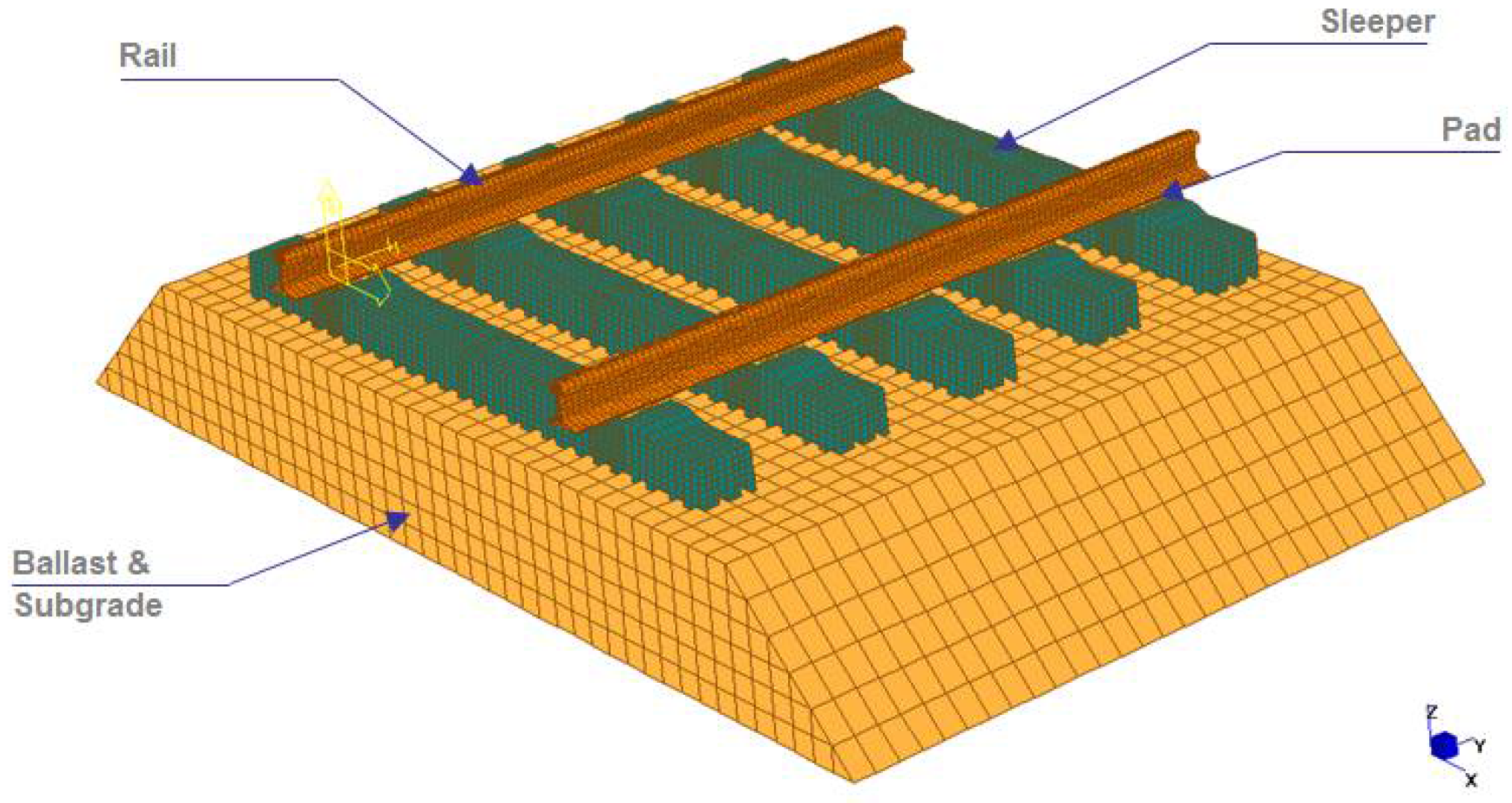
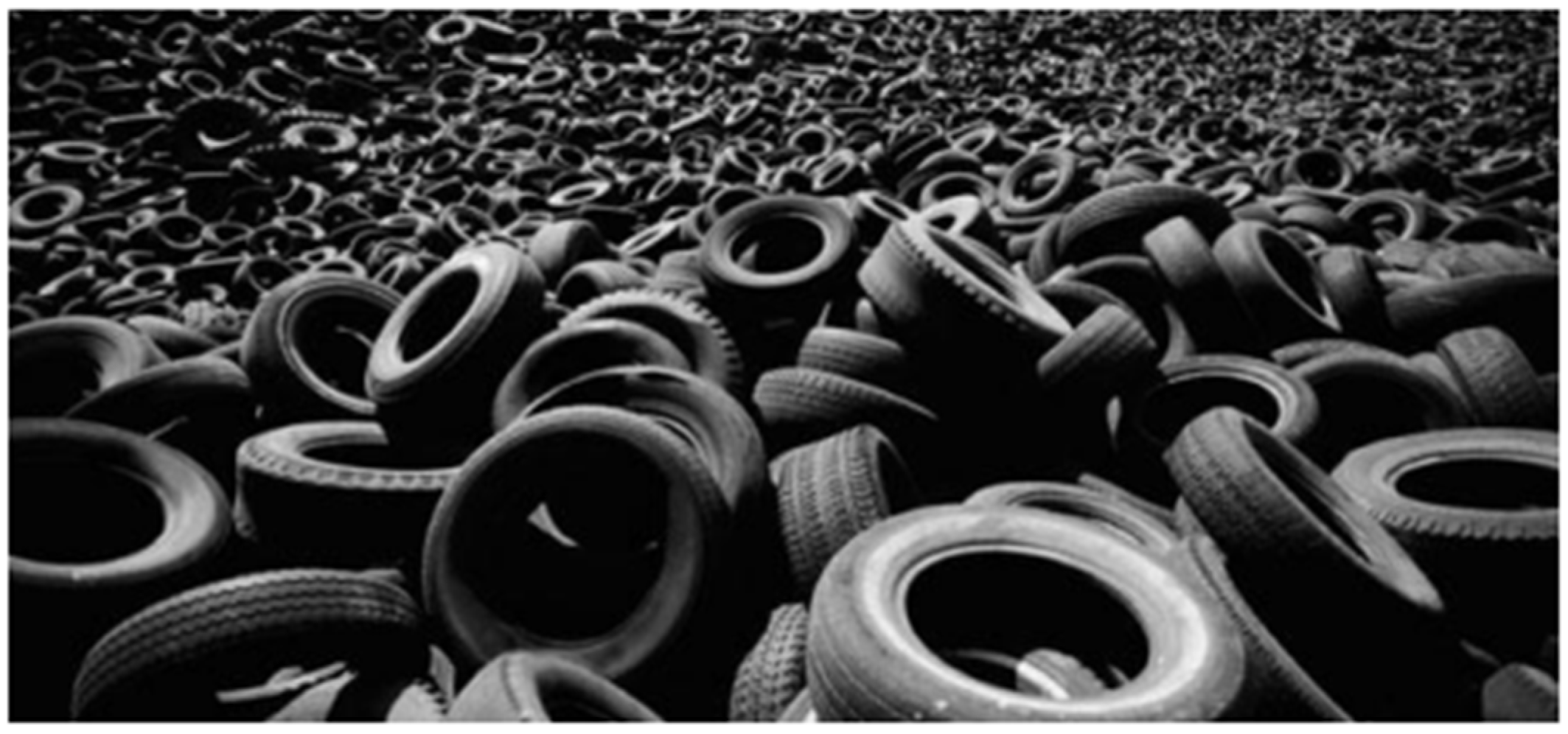
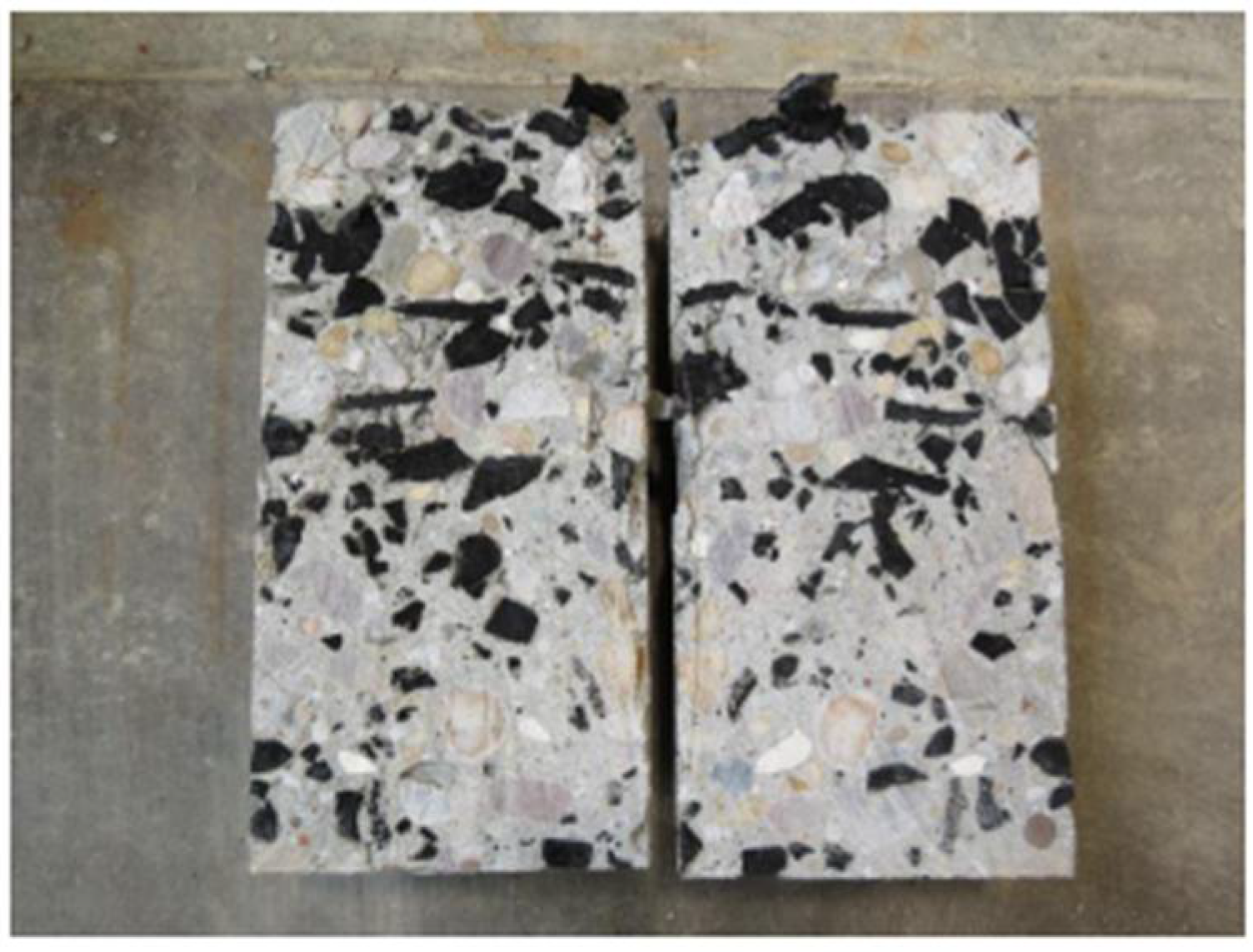
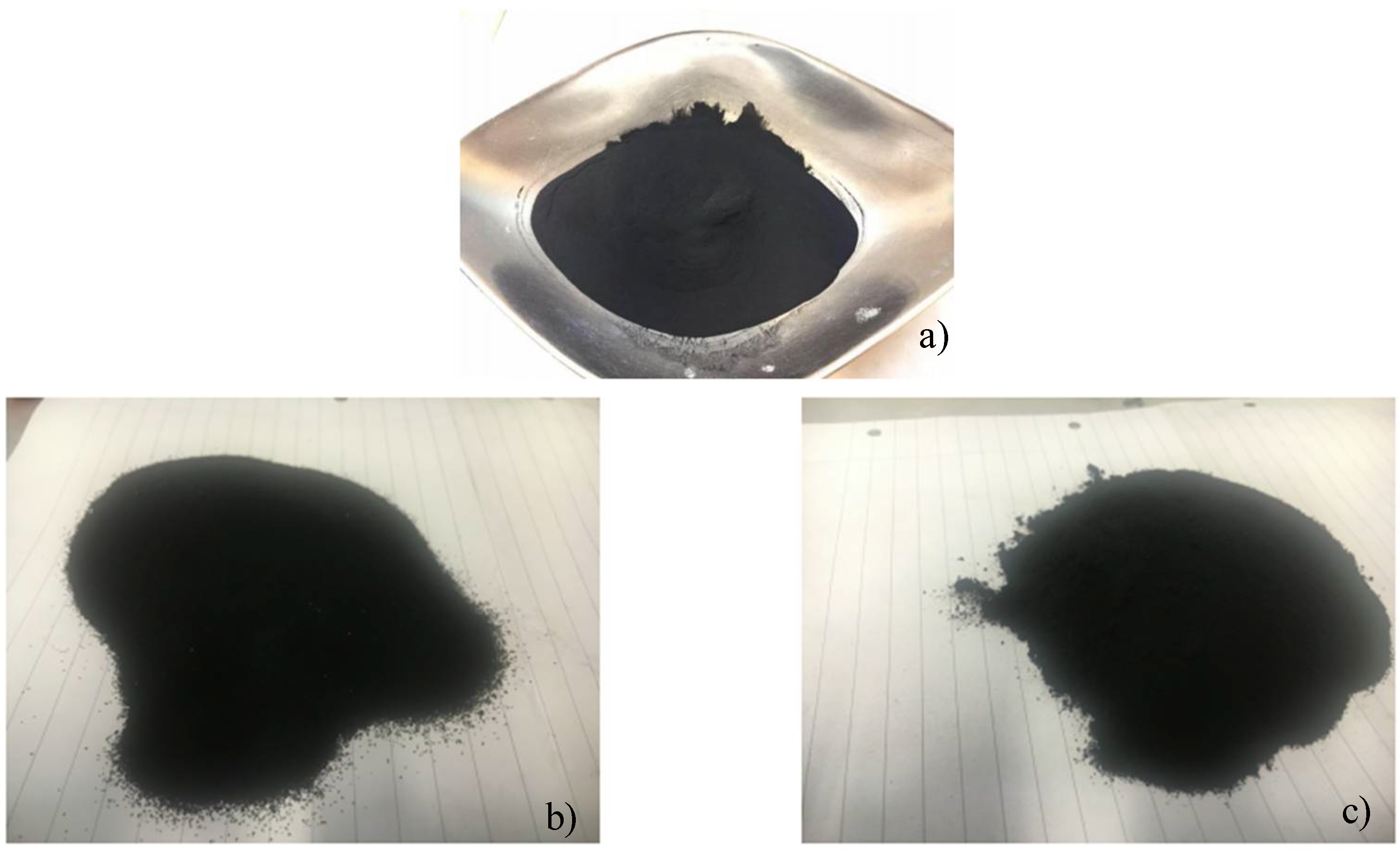
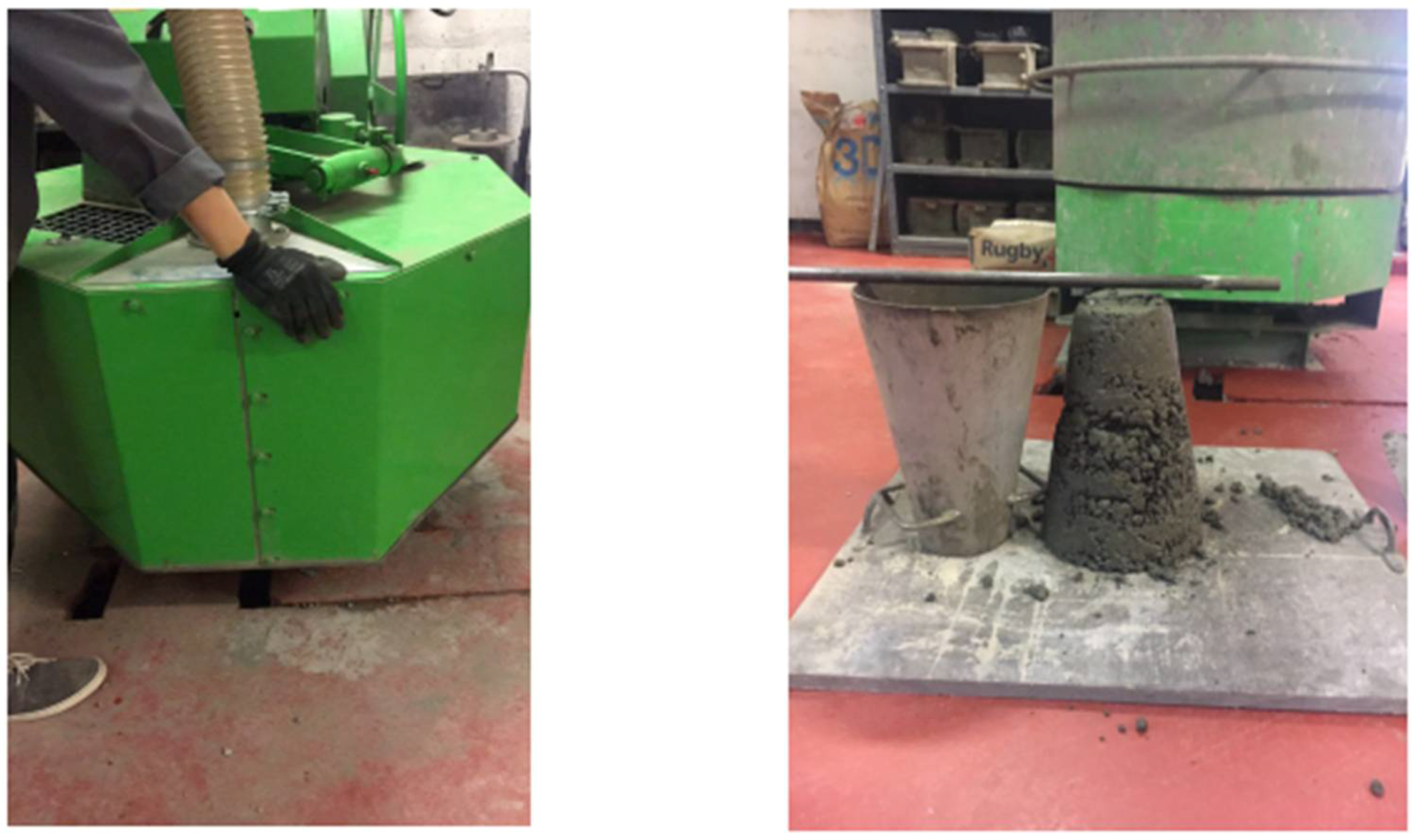

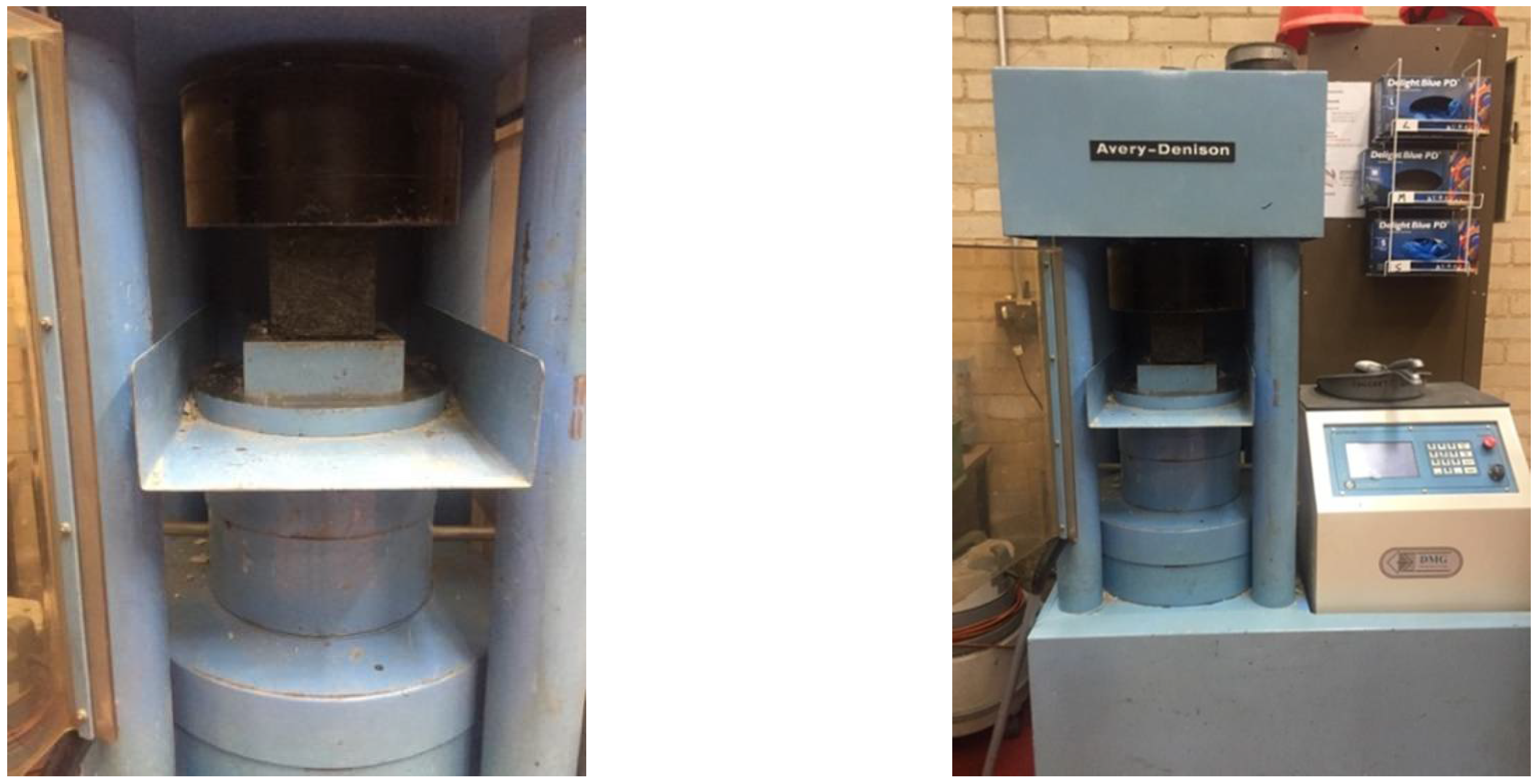
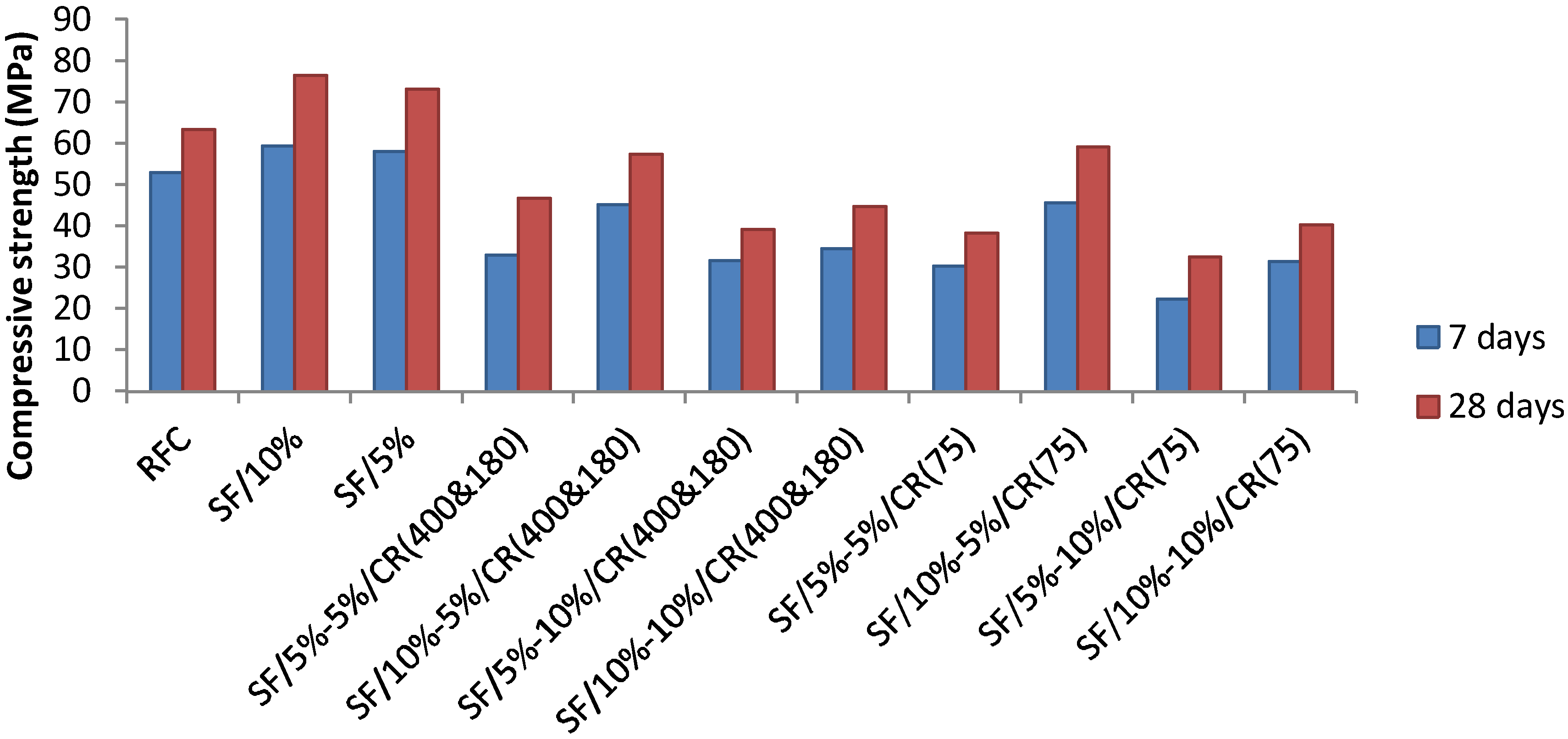
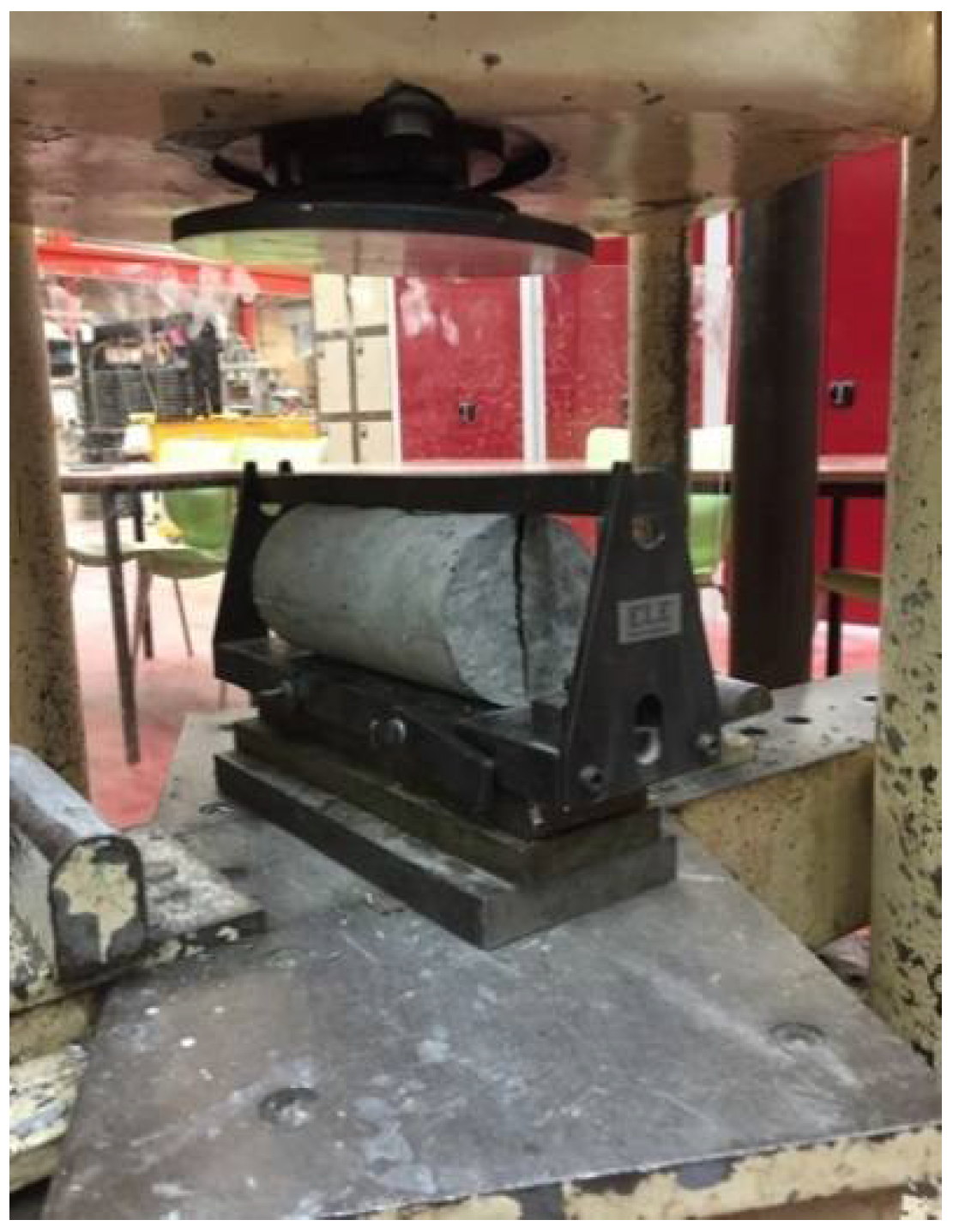
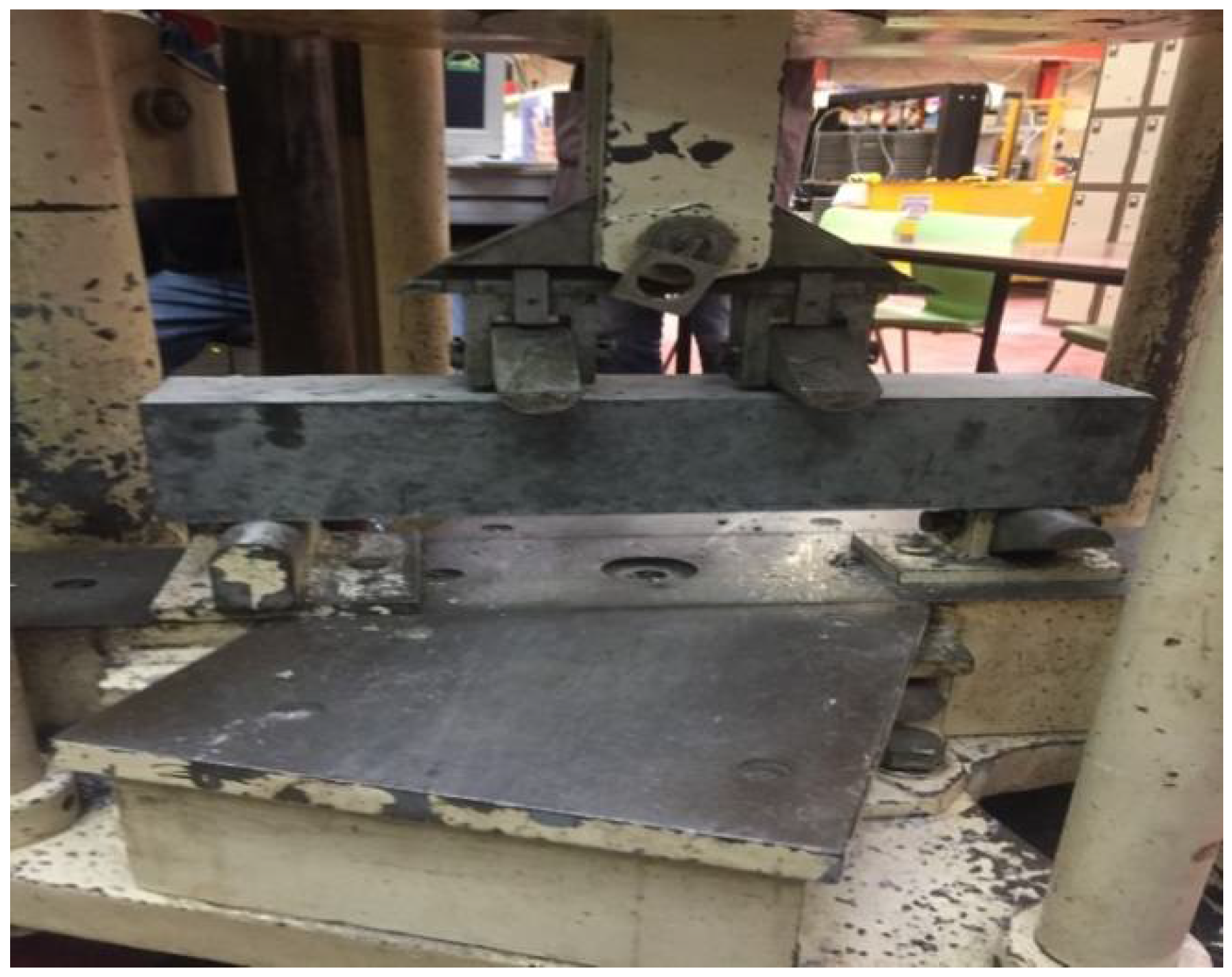

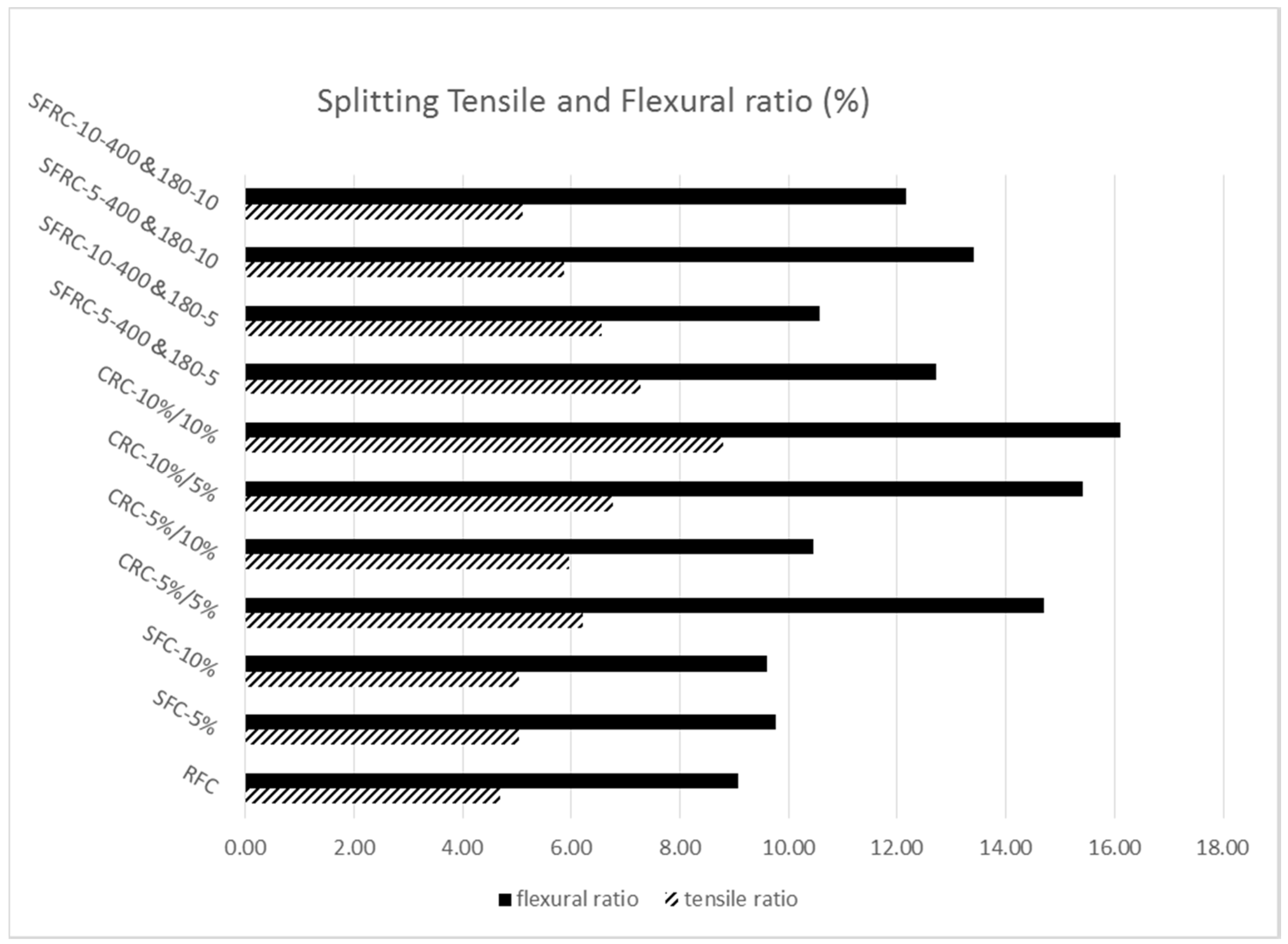
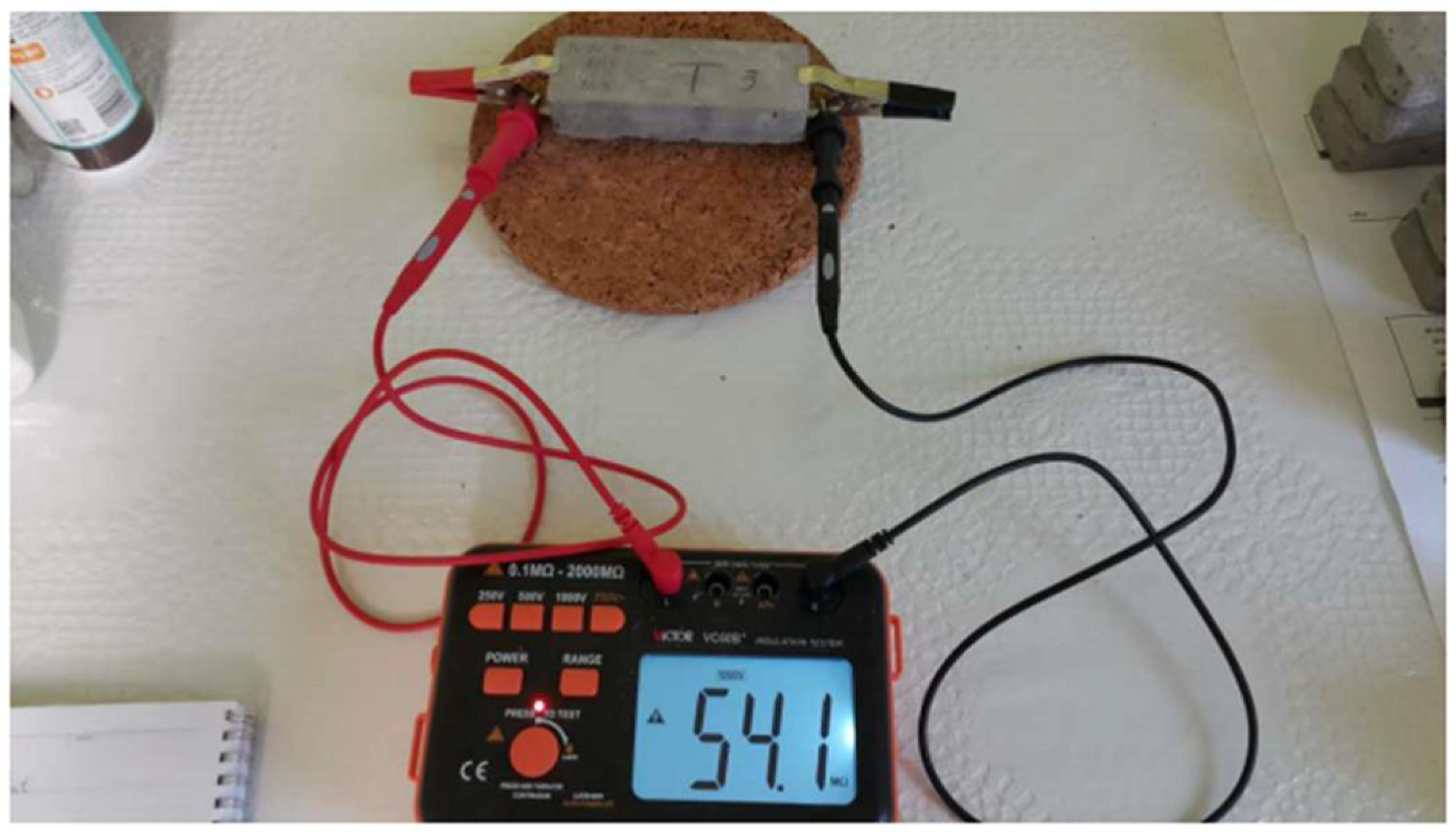
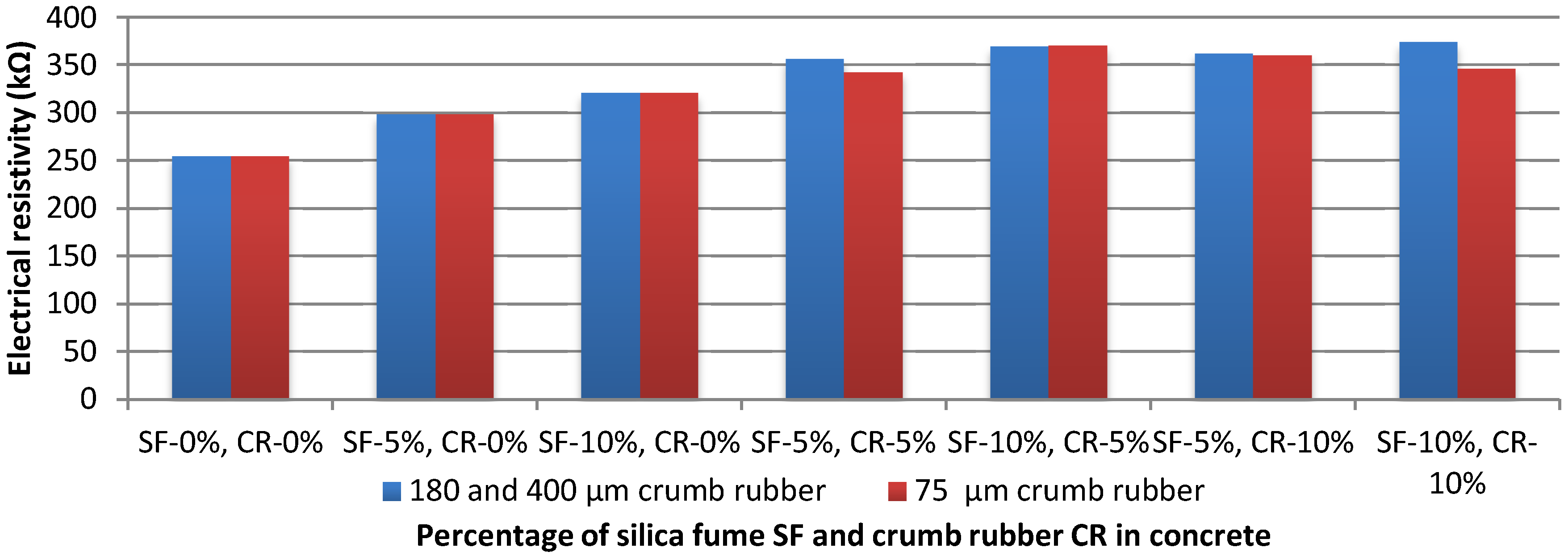
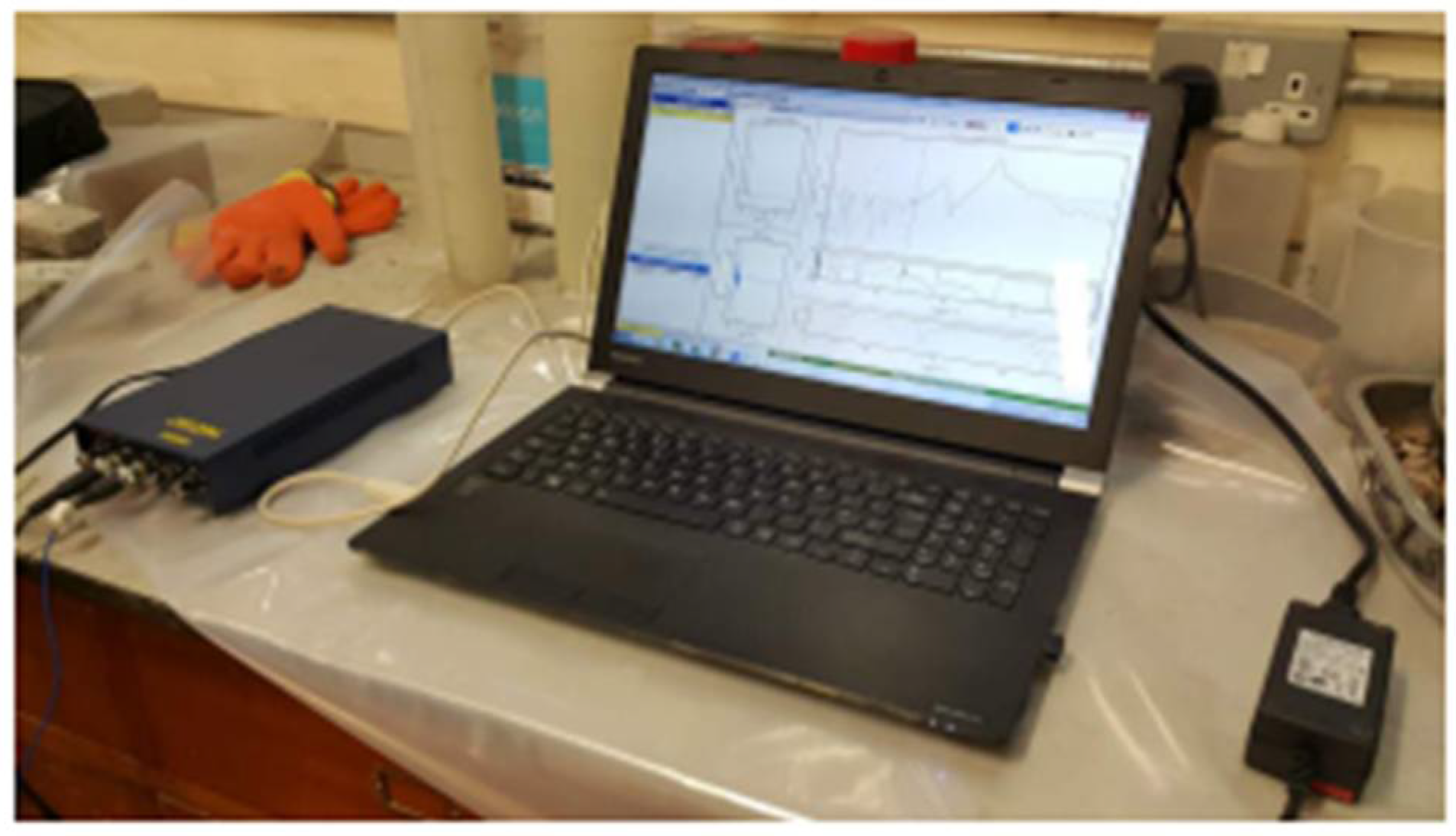
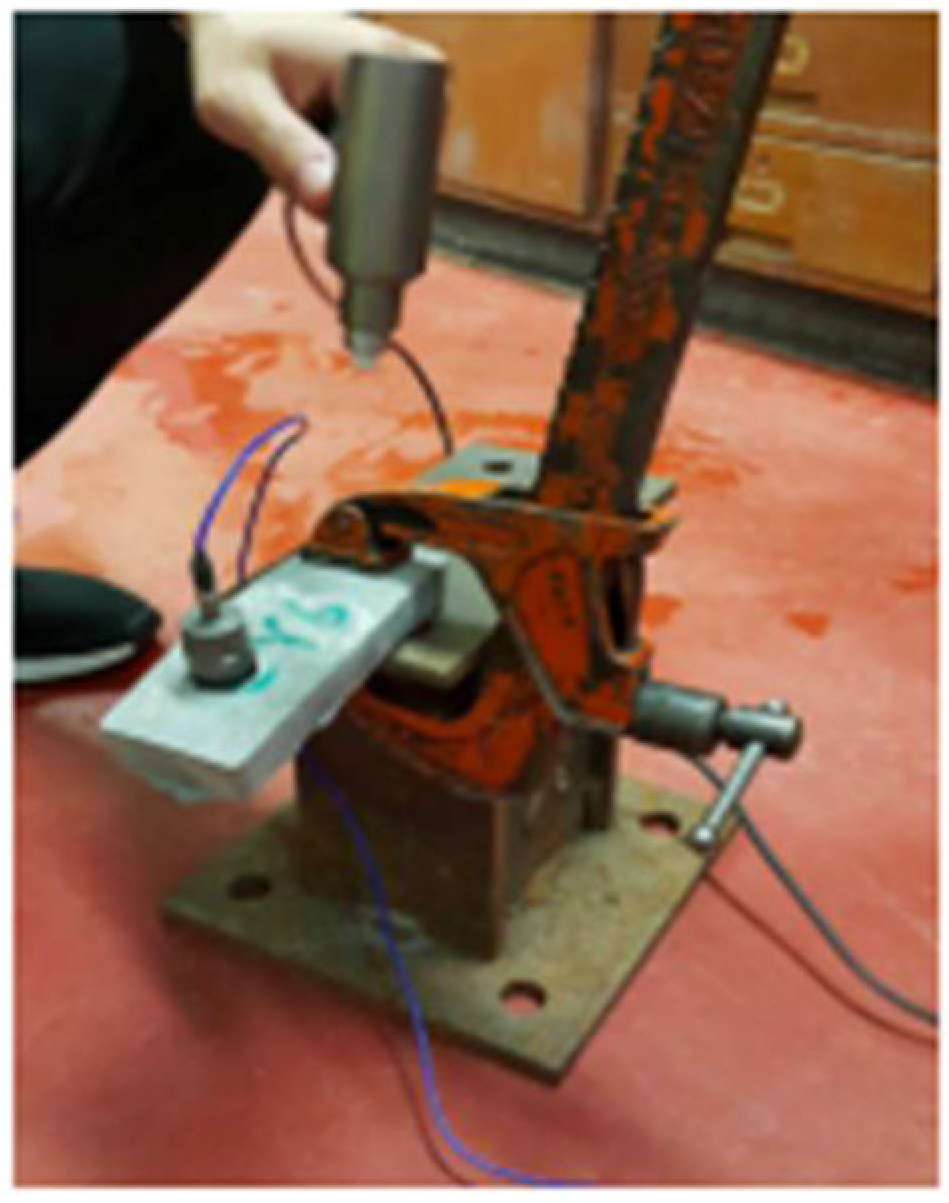
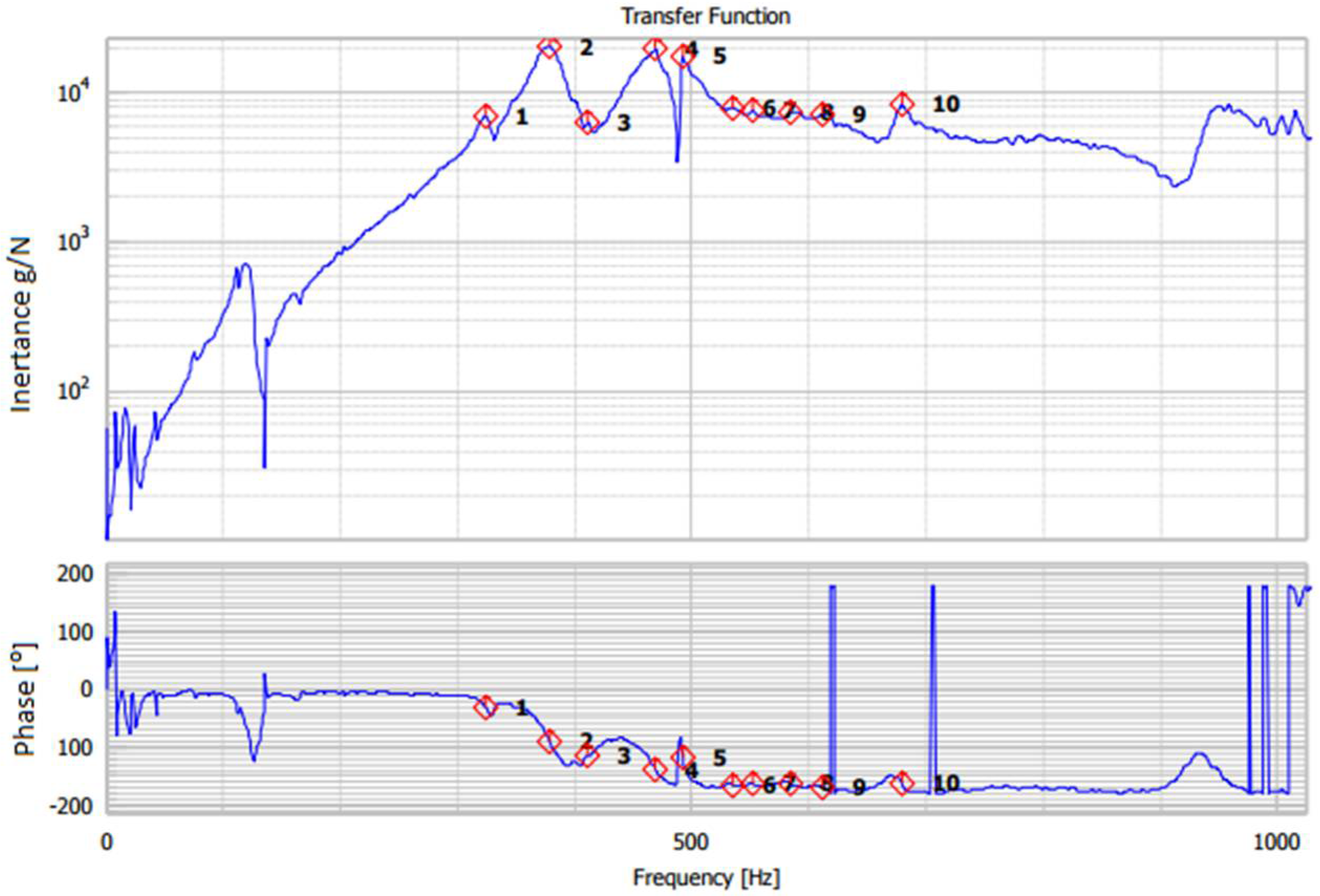

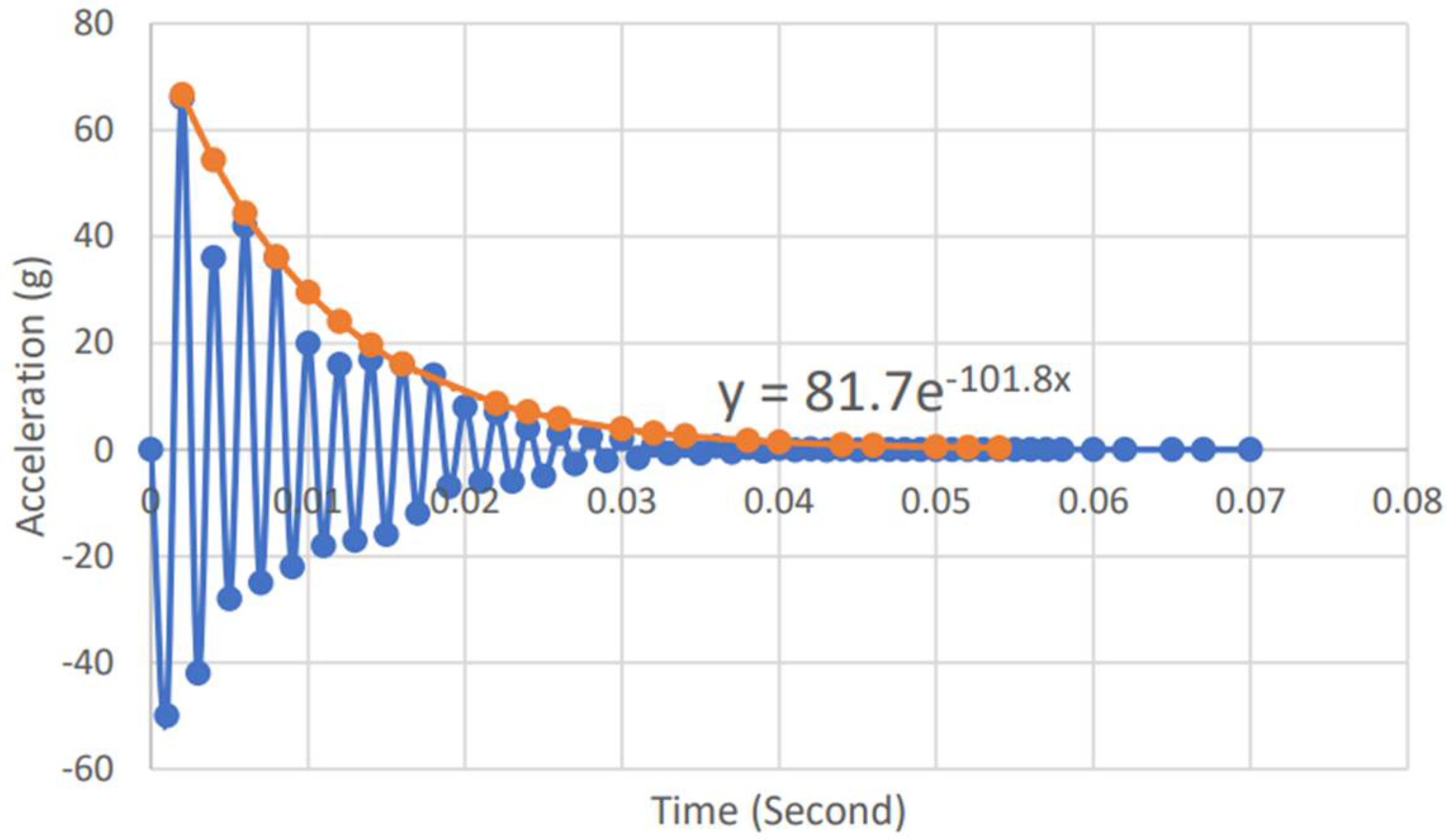
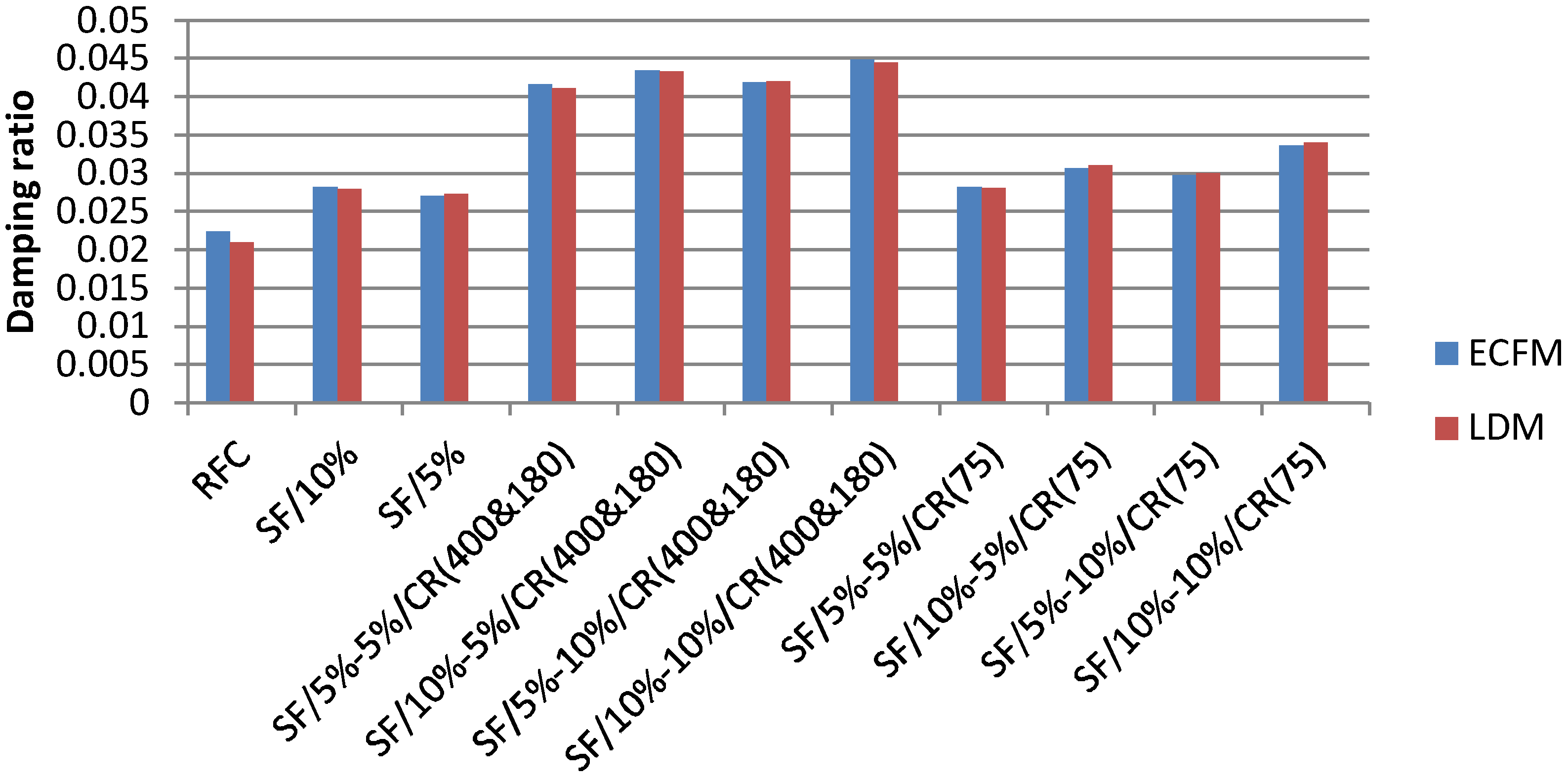
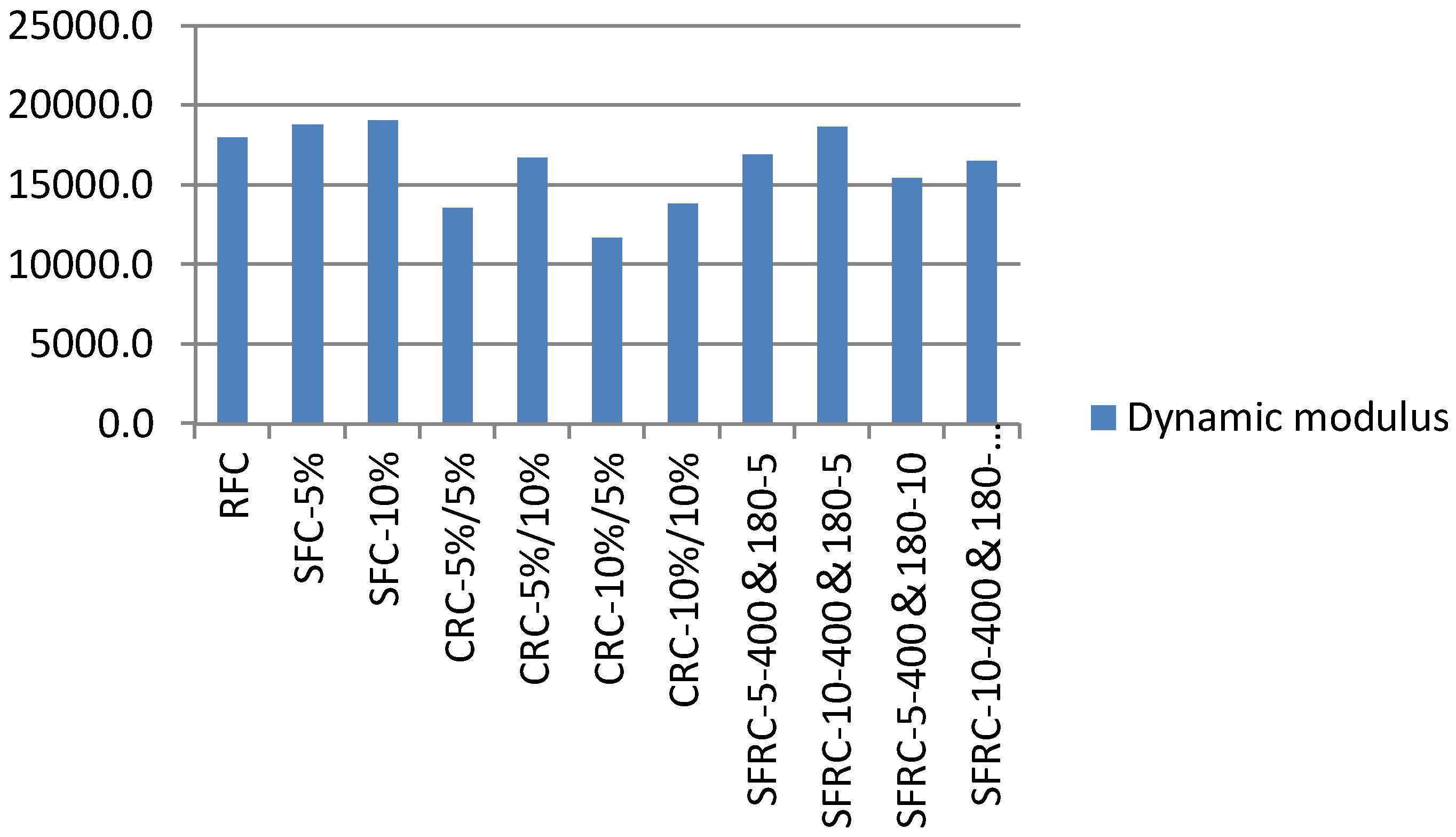
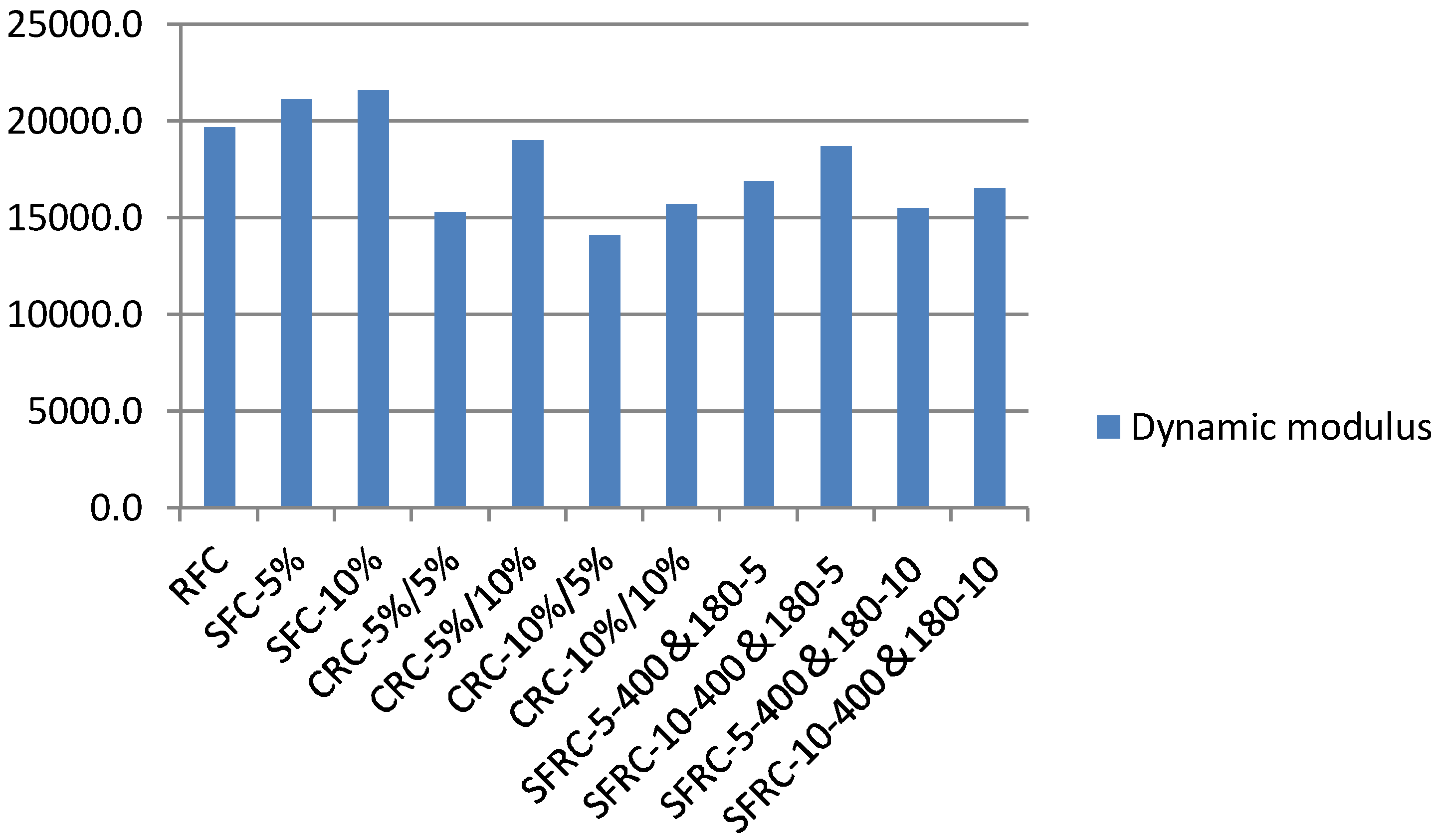
| No. | Properties | Value |
|---|---|---|
| 1 | SiO2 | Minimum 90% |
| 2 | Loss of Ignition | Maximum 3% |
| 3 | Coarse Particles > 45 μm | Maximum 1.5% (tested on undensified) |
| 4 | Bulk Density (U) | 200–350 kg/m3 |
| 5 | Bulk Density (D) | 500–700 kg/m3 |
| No. | Sieves (mm) | Weight Retained (g) | % Retained | Cumulative Retained | % Finer |
|---|---|---|---|---|---|
| 1 | 20 | 0 | 0% | 0 | 100% |
| 2 | 16 | 0 | 0% | 0 | 100% |
| 3 | 10 | 835 | 21% | 21% | 79% |
| 4 | 6.7 | 2710 | 67.5% | 88.5% | 11.5% |
| 5 | 4.75 | 355 | 9% | 97.5% | 2.5% |
| 6 | Base | 100 | 2.5% | 100% | 0% |
| Total | 4000 g |
| Main Components | Mixes A | Mixes B | |||||
|---|---|---|---|---|---|---|---|
| Ingredients kg/m3 | Cement | Water | Gravel | Sand | Silica Fume SF | Crumb Rubber CR (180 & 400 µm) | Crumb Rubber CR (75 µm) |
| SF-0%, CR-0% | 530 | 233 | 986 | 630 | - | - | - |
| SF-5%, CR-0% | 503 | 233 | 986 | 630 | 27 | - | - |
| SF-10%, CR-0% | 477 | 233 | 986 | 630 | 53 | - | - |
| SF-5%, CR-5% | 503 | 233 | 986 | 598 | 27 | 32 | 32 |
| SF-10%, CR-5% | 477 | 233 | 986 | 598 | 53 | 32 | 32 |
| SF-5%, CR-10% | 503 | 233 | 986 | 567 | 27 | 63 | 63 |
| SF-10%, CR-10% | 477 | 233 | 986 | 567 | 53 | 63 | 63 |
| Mould Type | Number of Samples per Mix | Type of Test |
|---|---|---|
| Cube 100 mm | 6 | Compressive strength |
| Cylinder Φ 100 × L200 mm | 3 | Splitting Tensile Strength |
| Prism W100 × H100 × L500 mm | 6 | Flexural Strength |
| Prism W45 × H20 × L120 mm | 4 | Electrical Resistivity, Vibration, and Damping |
| No. | Mixes | Natural Frequency (Hz) | S.D. | |||
|---|---|---|---|---|---|---|
| Sample 1 | Sample 2 | Sample 3 | Average | |||
| 1 | RFC | 478 | 451 | 486 | 471.67 | ±18.34 |
| 2 | SF/10% | 469 | 427 | 433 | 443 | ±22.716 |
| 3 | SF/5% | 457 | 437 | 462 | 452 | ±13.23 |
| 4 | SF/5%–5%/CR (400&180) | 476 | 452 | 463 | 463.67 | ±12.01 |
| 5 | SF/10%–5%/CR (400&180) | 456 | 439 | 454 | 449.67 | ±9.29 |
| 6 | SF/5%–10%/CR (400&180) | 479 | 493 | 474 | 482 | ±9.85 |
| 7 | SF/10%–10%/CR (400&180) | 441 | 446 | 435 | 440.67 | ±5.51 |
| 8 | SF/5%–5%/CR (75) | 443 | 462 | 431 | 445 | ±15.63 |
| 9 | SF/10%–5%/CR (75) | 477 | 500 | 459 | 477 | ±20.55 |
| 10 | SF/5%–10%/CR (75) | 453 | 456 | 472 | 460 | ±10.21 |
| 11 | SF/10%–10%/CR (75) | 488 | 493 | 512 | 498 | ±12.66 |
© 2018 by the authors. Licensee MDPI, Basel, Switzerland. This article is an open access article distributed under the terms and conditions of the Creative Commons Attribution (CC BY) license (http://creativecommons.org/licenses/by/4.0/).
Share and Cite
Kaewunruen, S.; Li, D.; Chen, Y.; Xiang, Z. Enhancement of Dynamic Damping in Eco-Friendly Railway Concrete Sleepers Using Waste-Tyre Crumb Rubber. Materials 2018, 11, 1169. https://doi.org/10.3390/ma11071169
Kaewunruen S, Li D, Chen Y, Xiang Z. Enhancement of Dynamic Damping in Eco-Friendly Railway Concrete Sleepers Using Waste-Tyre Crumb Rubber. Materials. 2018; 11(7):1169. https://doi.org/10.3390/ma11071169
Chicago/Turabian StyleKaewunruen, Sakdirat, Dan Li, Yu Chen, and Zhechun Xiang. 2018. "Enhancement of Dynamic Damping in Eco-Friendly Railway Concrete Sleepers Using Waste-Tyre Crumb Rubber" Materials 11, no. 7: 1169. https://doi.org/10.3390/ma11071169
APA StyleKaewunruen, S., Li, D., Chen, Y., & Xiang, Z. (2018). Enhancement of Dynamic Damping in Eco-Friendly Railway Concrete Sleepers Using Waste-Tyre Crumb Rubber. Materials, 11(7), 1169. https://doi.org/10.3390/ma11071169






